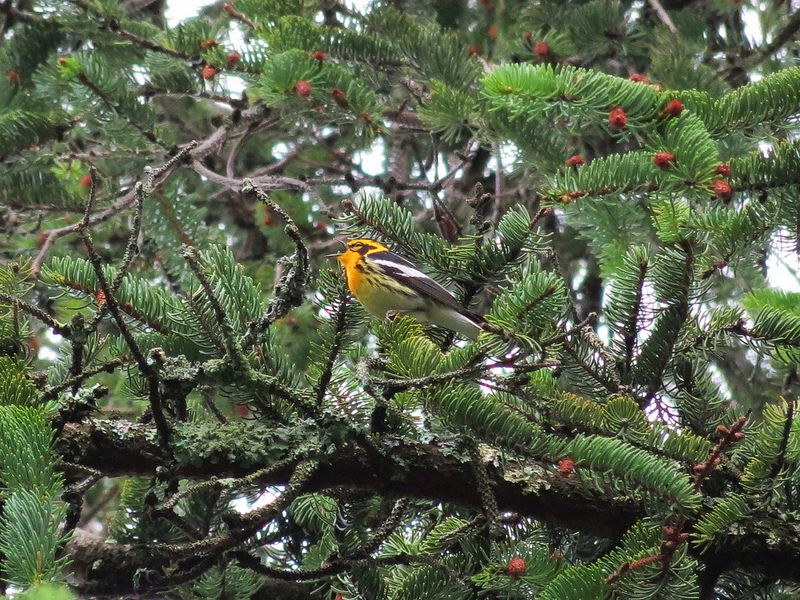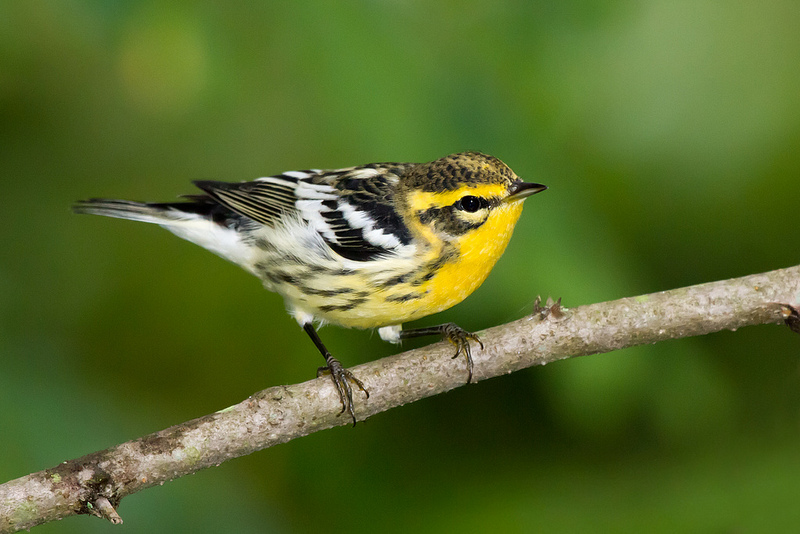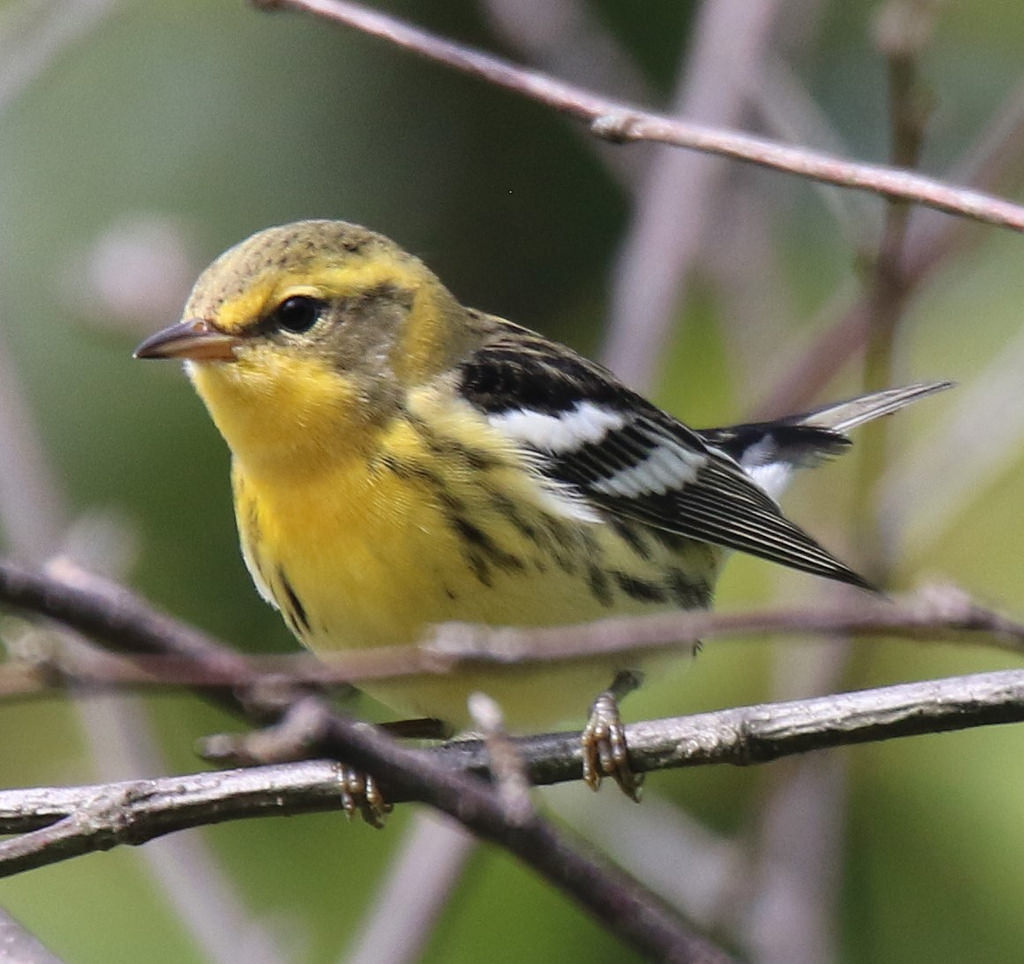Map Snapshot

























351 Records
Description
Conspicuous in adult male is a fiery orange throat, broad white wing patch, and triangular dark ear patch. Coloration in adult female and immature is more muted. The song is a short series of high notes followed by an ascending trill ending in a very high note.
Where To Find
Occurs throughout Maryland during spring and fall migration. Breeds in the western Maryland mountains. "Breeding birds are locally common in extensive stands of mature hemlock at elevations above 2,200 feet....It [Blackburnian] was undoubtedly common in the mature spruce forest that covered many Garrett County bogs before the close of the nineteenth century, but today so few mature spruces remain that the Blackburnian Warbler is confined largely to hemlock stands" (Robbins and Blom, 1996). Generally stays in the upper branches.
Relationships
"The old-growth hemlock stand along the Youghiogheny River in Swallow Falls State Park [Garrett County] is one of the best places for finding Blackburnian Warblers.... [N]umbers [of breeding Blackburnians in Maryland] have almost certainly declined as mature spruce trees have been cut and fragmentation of mature eastern hemlock groves has continued.... [T]he Blackburnian does not defend territories with only one or two spruce trees; it requires extensive old-growth forest...." (Robbins and Blom, 1996). Brown-headed Cowbird parasitism is another major reason for the decline.
Seasonality Snapshot
Source: Wikipedia
| Blackburnian warbler | |
|---|---|

| |
| Adult male in New York | |
| Scientific classification | |
| Domain: | Eukaryota |
| Kingdom: | Animalia |
| Phylum: | Chordata |
| Class: | Aves |
| Order: | Passeriformes |
| Family: | Parulidae |
| Genus: | Setophaga |
| Species: | S. fusca
|
| Binomial name | |
| Setophaga fusca (Müller, 1776)
| |

| |
| Range of S. fusca Breeding range Wintering range
| |
| Synonyms | |
|
Dendroica blackburniae | |
The Blackburnian warbler (Setophaga fusca) is a small New World warbler. They breed in eastern North America, from southern Canada, westwards to the southern Canadian Prairies, the Great Lakes region and New England, to North Carolina.
Blackburnian warblers are migratory, wintering in southern Central America and South America, and are very rare vagrants to western Europe.
Etymology
[edit]The genus name Setophaga is from the Ancient Greek ses, "moth", and phagos, "eating". The specific fusca is Latin for brown.[2]
The common name is for Anna Blackburne, an English botanist.[3]
Description
[edit]

Blackburnian warblers are small passerines and average-sized wood-warblers. They measure around 11 to 13 cm (4.3 to 5.1 in) long, with a 20 to 22 cm (7.9 to 8.7 in) wingspan, and weigh 8 to 13 g (0.28 to 0.46 oz). The average mass of an adult bird is 9.7 g (0.34 oz), although is slightly higher in fall due to fat reserves, averaging 10.2–10.4 g (0.36–0.37 oz).[4] Among standard measurements, the wing chord is 6.3 to 7.3 cm (2.5 to 2.9 in), the tail is 4.2 to 5 cm (1.7 to 2.0 in), the bill is 0.9 to 1 cm (0.35 to 0.39 in) and the tarsus is 1.6 to 1.8 cm (0.63 to 0.71 in).[5] In summer, male Blackburnian warblers display dark gray backs and double white wing bars, with yellowish rumps and dark brown crowns. The underparts of these birds are white and are tinged with yellow and streaked black. The head is strongly patterned in yellow and black, with a flaming-orange throat. It is the only North American warbler with this striking plumage. Other plumages, including the fall male and adult female, are washed-out versions of the summer male, and in particular, lack the bright colors and strong head pattern. The Blackburnian warbler is practically unmistakable if seen well, even the female due to her dull-yellow supercilium, contrasting with greyish cheeks and yellow throat contrasting with the dark streaky sides and back. The only other wood-warbler with an orange throat is the flame-throated warbler of Central America, which is very distinctive, lacking the contrasting blackish streaking about the head and whitish underside of a male Blackburnian.[6] Basic plumages show weaker yellows and gray in place of black in the breeding male. Blackburnian warblers' songs are a simple series of high swi notes, which often ascend in pitch. Transliterations have included zip zip zip zip zip zip zip zip, titititi tseeeeee or teetsa teetsa teetsa teetsa.[7] Their call is a high sip. Genetic research has shown that their close living relative is the bay-breasted warbler, the latter species perhaps specialized to forage in the same coniferous trees at lower levels.[8] Hybridization in the wild has been recorded once each with a bay-breasted warbler (in West Virginia), with a black-and-white warbler (in Pennsylvania), and possibly a wintering hybrid with a Kirtland's warbler (in Hispaniola).[9][10][11]
Ecology
[edit]Blackburnian warblers are solitary during winter, highly territorial on their breeding grounds, and do not mix with other passerine species outside of the migratory period. However, during migration, they often join local mixed foraging flocks of species such as chickadees, kinglets, and nuthatches. Similarly, in the tropics, they were found to be fairly social while engaging in migration but solitary from other passerines while wintering.[12] These birds are basically insectivorous but will include berries in their diets in wintertime. They usually forage by searching for insects or spiders in treetops. Their breeding season diet is dominated by the larvae of Lepidoptera, i.e. moths and butterflies.[13] They may help control the spruce budworm (often considered a harmful pest) when breakouts occur, at the local if not at epidemic level.[14] In one study from Ontario, 98% of the diet was made of insects, the remaining 2% being spiders.[15] Among the migratory Setophaga warblers, it is considered one of the specialists at foraging in the micro-habitat of the tree's top canopy.[16]
The breeding habitats of these birds are mature coniferous woodlands, the central part of their breeding range being in the southeastern portion of Canada's boreal forest. However, their distribution as a breeding species continues broadly down much of New England and the Appalachian Mountains, from New York to northernmost Georgia, in elevated mixed woodlands, especially ones containing spruce and hemlocks.[17] Hemlocks in particular are most likely to host Blackburnian warblers in mixed forests.[18] It typically winters in tropical montane forests, from roughly 600 to 2,500 m (2,000 to 8,200 ft), mainly from Colombia to Peru, more sporadically in Panama and the Amazon region.[19][20][21]
Blackburnian warblers begin their first clutches in mid-May to early June in the contiguous United States and about 1 to 2 weeks later in Quebec.[12] This species builds a nest consisting of an open cup of twigs, bark, plant fibers, and rootlets held to a branch with a spider web and lined with lichens, moss, hair, and dead pine needles, that is placed near the end of a branch. Although typically only laying one brood per year, if a nest is destroyed they are capable of producing a second or even third brood.[22] Three to five whitish eggs are laid in its nest which is usually placed 2–38 m (6.6–124.7 ft) above the ground, on a horizontal branch.[23] Nests usually constructed outwardly with twigs, bark, plant fibers, and rootlets; lined with lichens, mosses, fine grasses, hair, dead pine needles, and even occasionally such exotic substances as string, willow cotton, horsehair, and cattail down.[17] Only the female broods and spends about 80% day actively brooding, with the male usually helping bring food to the nest.[24] Among warblers, they are relatively rarely parasitized at the nest by brown-headed cowbirds, most likely due to the cowbirds' lack of success in dense pine-dominated forests.[25][26] Blue jays and American red squirrels have been verified to prey on nestlings and new fledglings, while a merlin was recorded killing a brooding adult female. Sharp-shinned hawks and Cooper's hawks are likely, but not confirmed, predators of adult Blackburnian warblers.[17] By far the greatest threat faced by this species is the destruction of forest habitat, which some predict could cause the Blackburnian warbler to lose up to more than 30% of its wintering or breeding habitat.[27][28] However, currently, this species continues to occur over a large range and can appear in stable numbers where habitat is appropriate.[17]
References
[edit]- ^ BirdLife International (2016). "Setophaga fusca". IUCN Red List of Threatened Species. 2016: e.T22721695A94724546. doi:10.2305/IUCN.UK.2016-3.RLTS.T22721695A94724546.en. Retrieved 12 November 2021.
- ^ Jobling, James A. (2010). The Helm Dictionary of Scientific Bird Names. London, United Kingdom: Christopher Helm. pp. 167, 355. ISBN 978-1-4081-2501-4.
- ^ Wystrach, V. P. (May 12, 1977). "Anna Blackburne (1726-1793)–a neglected patroness of natural history". Journal of the Society for the Bibliography of Natural History. 8 (2): 148–168. doi:10.3366/jsbnh.1977.8.2.148.
- ^ Graber, J. W., R. R. Graber, and E. L. Kirk. 1983. Illinois birds: wood warblers. Biological Notes No. 118. III. Nat. Hist. Surv. Urbana, IL.
- ^ Curson, Jon; Quinn, David; Beadle, David (1994). New World Warblers. London: Christopher Helm. ISBN 0-7136-3932-6.
- ^ Dunn, J. and K. Garrett. 1997. A field guide to warblers of North America. Houghton Mifflin, Boston.
- ^ Ficken, M. S. and R. W. Ficken. 1962. The comparative ethology of the wood warblers: a review. Living Bird 1:103-122.
- ^ Lovette, I. J. and E. Bermingham. 1999. Explosive speciation in the New World Dendroica warblers. Proc. R. Soc. London B 266:1629-1636.
- ^ Hurley, G. F. and J. W. Jones II. 1983. A presumed mixed Bay-breasted x Blackburnian Warbler nesting in West Virginia. Redstart 50:108-111.
- ^ Parkes, K. C. 1983. Three additional hybrid combinations in North American birds. Abstract of paper presented at the 101st stated meeting of the American Ornithologists' Union.
- ^ Latta, S. C. and K. C. Parkes. 2001. A possible Dendroica kirtlandii hybrid from Hispaniola. Wilson Bull. 113:378-383.
- ^ a b Bent, A. C. 1953. Life histories of North American wood warblers. U.S. Natl. Mus. Bull. 203.
- ^ Morse, D. H. 1976. Variables determining the density and territory site of breeding spruce-woods warblers. Ecology 57:290-301.
- ^ Crawford, H. S., R. W. Titterington, and D. T. Jennings. 1983. Bird predation and spruce budworm populations. J. For. 81:433-435.
- ^ Kendeigh, S. C. 1947. Bird population studies in the coniferous forest biome during a spruce budworm outbreak. Dept. Lands Forests, Ontario, Canada, Biol. Bull. 1:1-100.
- ^ Morse, D. H. 1968. A quantitative study of foraging of male and female spruce woods warblers. Ecology 49:779-784.
- ^ a b c d Morse, Douglass H. 2004. Blackburnian Warbler (Setophaga fusca), The Birds of North America Online (A. Poole, Ed.). Ithaca: Cornell Lab of Ornithology.
- ^ Kendeigh, S. C. 1945b. Nesting behavior of wood warblers. Wilson Bull. 57:145-164.
- ^ Hilty, S. L. and W. L. Brown. 1986. A guide to the birds of Colombia. Princeton Univ. Press, Princeton, NJ.
- ^ Ridgely, R. S. and J. A. Gwynne. 1989. A guide to the birds of Panama. 2nd ed. Princeton Univ. Press, Princeton, NJ.
- ^ Stotz, D. F., R. O. Bierregaard, M. Cohn-Haft, P. Petermann, J. Smith, A. Whittaker, and S. V. Wilson. 1992. The status of North American migrants in central Amazonian Brazil. Condor 94:608-621.
- ^ Morse, D. H. 1989. American warblers: an ecological and behavioral perspective. Harvard Univ. Press, Cambridge, MA.
- ^ "Blackburnian Warbler". All about Birds. Cornell Lab of Ornithology.
- ^ Lawrence, L. de K. 1953. Notes on the nesting behavior of the Blackburnian Warbler. Wilson Bull. 65:135-144.
- ^ Peck, G. K. and R. D. James. 1989. Breeding birds of Ontario: nidiology and distribution. Royal Ont. Museum, Toronto.
- ^ Merriam, C. H. 1885. Nest and eggs of the Blackburnian Warbler. Auk 2:103.
- ^ Webb, W. L., D. F. Behrend, and B. Saisorn. 1983. Effect of logging on songbird populations in a northern hardwood forest. Wildl. Monogr. 55:1-35.
- ^ Diamond, A. W. 1991. Assessment of the risks from tropical deforestation to Canadian songbirds. Trans. NA Wildl. Nat. Res. Conf. 56:177-194.
Further reading
[edit]Books
[edit]- Morse, D. H. (2004). Blackburnian Warbler (Dendroica fusca). The Birds of North America Online. (A. Poole, Ed.) Ithaca: Cornell Laboratory of Ornithology; Retrieved from The Birds of North American Online database
Theses
[edit]- Hamady MA. Ph.D. (2000). An ecosystem approach to assessing the effects of forest heterogeneity and disturbance on birds of the northern hardwood forest in Michigan's Upper Peninsula. Michigan State University, United States, Michigan.
- Young LA. M.Sc.F. (2004). Habitat use and behaviour of the blackburnian warbler, Dendroica fusca, in an Acadian forest. University of New Brunswick (Canada), Canada.
Articles
[edit]- Adams DA & Hammond JS. (1991). Changes in Forest Vegetation Bird and Small Mammal Populations at Mount Mitchell North Carolina USA 1959-62 and 1985. Journal of the Elisha Mitchell Scientific Society. vol 107, no 1. pp. 3–12.
- Betts MG, Forbes GJ, Diamond AW & Taylor PD. (2006). Independent effects of fragmentation on forest songbirds: An organism-based approach. Ecological Applications. vol 16, no 3. pp. 1076–1089.
- Betts MG, Zitske BP, Hadley AS & Diamond AW. (2006). Migrant forest songbirds undertake breeding dispersal following timber harvest. Northeast Nat. vol 13, no 4. pp. 531–536.
- Bub BR, Flaspohler DJ & Huckins CJF. (2004). Riparian and upland breeding-bird assemblages along headwater streams in Michigan's Upper Peninsula. Journal of Wildlife Management. vol 68, no 2. pp. 383–392.
- Burris JM & Haney AW. (2005). Bird communities after blowdown in a late-successional Great Lakes spruce-fir forest. Wilson Bulletin. vol 117, no 4. pp. 341–352.
- Clark WH & Kendall SS. (1986). 1ST RECORD OF THE BLACKBURNIAN WARBLER, DENDROICA-FUSCA, FROM THE CENTRAL DESERT IN BAJA-CALIFORNIA, MEXICO. Southwestern Naturalist. vol 31, no 4. pp. 544–544.
- Clark WH & Kendall SS. (1986). First Record of the Blackburnian Warbler Dendroica-Fusca New-Record from the Central Desert in Baja California Mexico. Southwestern Naturalist. vol 31, no 4.
- Cumming EE. (2004). Habitat segregation among songbirds in old-growth boreal mixedwood forest. Canadian Field Naturalist. vol 118, no 1. pp. 45–55.
- Cumming EE & Diamond AW. (2002). Songbird community composition versus forest rotation age in Saskatchewan boreal mixedwood forest. Canadian Field Naturalist. vol 116, no 1. pp. 69–75.
- Doepker RV, Earle RD & Ozoga JJ. (1992). Characteristics of blackburnian warbler, Dendroica fusca, breeding habitat in Upper Michigan. Canadian Field Naturalist. vol 106, no 3. pp. 366–371.
- Faccio SD. (2003). Effects of ice storm-created gaps on forest breeding bird communities in central Vermont. Forest Ecology & Management. vol 186, no 1-3. pp. 133–145.
- Girard C, Darveau M, Savard J-PL & Huot J. (2004). Are temperate mixedwood forests perceived by birds as a distinct forest type?. Canadian Journal of Forest Research. vol 34, no 9. pp. 1895–1907.
- Hobson KA & Bayne E. (2000). Breeding bird communities in boreal forest of western Canada: Consequences of "unmixing" the mixedwoods. Condor. vol 102, no 4. pp. 759–769.
- Hobson KA & Bayne E. (2000). Effects of forest fragmentation by agriculture on avian communities in the southern boreal mixedwoods of western Canada. Wilson Bulletin. vol 112, no 3. pp. 373–387.
- Johnels SA & Cuadros TC. (1986). Species Composition and Abundance of Bird Fauna in a Disturbed Forest in the Central Andes of Colombia. Hornero. vol 12, no 4. pp. 235–241.
- Johnson WNJ & Brown PW. (1990). Avian Use of a Lakeshore Buffer Strip and an Undisturbed Lakeshore in Maine USA. Northern Journal of Applied Forestry. vol 7, no 3. pp. 114–117.
- Lacki MJ. (2000). Surveys of bird communities on Little Black and Black mountains: Implications for long-term conservation of Montane birds in Kentucky. Journal of the Kentucky Academy of Sciences. vol 61, no 1. pp. 50–59.
- Latta SC & Parkes KC. (2001). A possible Dendroica kirtlandii hybrid from hispaniola. Wilson Bulletin. vol 113, no 4. pp. 378–383.
- Lerner SDZ & Stauffer DF. (1998). Habitat selection by Blackburnian Warblers wintering in Colombia. Journal of Field Ornithology. vol 69, no 3. pp. 457–465.
- Morse DH. (1977). The Occupation of Small Islands by Passerine Birds. Condor. vol 79, no 4. pp. 399–412.
- Ports MA. (1981). Miscellaneous Summer Records of Birds from Southwestern Kansas USA. Transactions of the Kansas Academy of Science. vol 84, no 2. pp. 109–114.
- Ross RM, Redell LA, Bennett RM & Young JA. (2004). Mesohabitat use of threatened hemlock forests by breeding birds of the Delaware River basin in northeastern United States. Natural Areas Journal. vol 24, no 4. pp. 307–315.
- Saunders D & Saunders S. (1992). Blackburnian Warbler New to the Western Palearctic. British Birds. vol 85, no 7. pp. 337–343.
- Schulte LA, Pidgeon AM & Mladenoff DJ. (2005). One hundred fifty years of change in forest bird breeding habitat: Estimates of species distributions. Conservation Biology. vol 19, no 6. pp. 1944–1956.
- Skinner C. (2003). A breeding bird survey of the natural areas at Holden Arboretum. Ohio Journal of Science. vol 103, no 4. pp. 98–110.
- Stewart PA. (1986). Fall Migration of Twelve Species of Wood Warblers through Coastal Virginia USA. North American Bird Bander. vol 11, no 3. pp. 83–88.
- Tingley MW, Orwig DA, Field R & Motzkin G. (2002). Avian response to removal of a forest dominant: Consequences of hemlock woolly adelgid infestations. Journal of Biogeography. vol 29, no 10-11. pp. 1505–1516.
- Venier LA, McKenney DW, Wang Y & McKee J. (1999). Models of large-scale breeding-bird distribution as a function of macro-climate in Ontario, Canada. Journal of Biogeography. vol 26, no 2. pp. 315–328.
- Young L, Betts MG & Diamond AW. (2005). Do Blackburnian Warblers select mixed forest? The importance of spatial resolution in defining habitat. For Ecol Manage. vol 214, no 1-3. pp. 358–372.
External links
[edit]- "Blackburnian warbler media". Internet Bird Collection.
- Blackburnian warbler species profile - The Nature Conservancy
- Blackburnian warbler species account - Cornell Lab of Ornithology
- Blackburnian warbler - Dendroica fusca - USGS Patuxent Bird Identification InfoCenter
- Stamps[usurped] (for Cuba, Grenada) with Range Map at bird-stamps.org
- Blackburnian warbler photo gallery at VIREO (Drexel University)

























